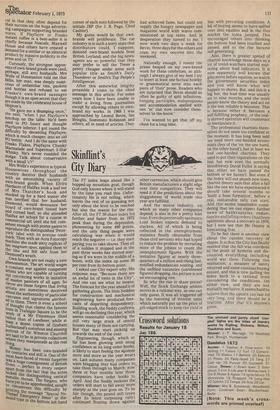Skinflint's City Diary
The FT index leaps ahead like a hopped-up mountain goat, though God only knows where it will stand by the time you read this. Unfortunately He is not telling, which leaves the rest of us guessing not only about the level to be reached but also the reason for the rise.
After all, the FT 30-share index fell further and faster from its 1972 peak than during the depression, plummeting by some 400 points, and the only thing people were calculating was when it would reach the negative — i.e. they start paying you to take shares. Then all of a sudden it stopped and in the past three weeks has started soaring as if we were in the middle of a boom, with the index up some 30 per cent from its bottom point. I asked one City expert why. His response was: "Because there are
an awful lot of twits in the City". And one can see what he means. The forecast for the year ahead is.of gathering gloom. The little Neddies for construction and mechanical engineering have produced forecasts of dispiriting despondency. Building work, the Neddy confirms, will go on declining this year, which seems reasonable considering the Still very large stock of unsold houses many of them are carrying. But that may start picking up towards the end of the year.
Engineering, though, which so far has been glowing with smug confidence at its long order books, is likely to start feeling the squeeze more and more as the year wears on. Last autumn many companies were bragging they had orders to take them through to March; now three or four months later those companies have order books to April. And the Neddy reckons the orders will start to fall away more sharply as the year goes on. To be fair though, the pound still (even after its latest surprising rally) continued floating down against other currencies, which should give British manufacturers a slight edge over their competitors. They will need it if the predictions about the sluggishness of world trade this year are fulfilled.
And the motor industry, on which so many other companies depend, is also in for a pretty lean time. Even theperenn ially optimistic Lord Stokes expects demand to slacken. All of which is being reflected in the unemployment statistics finally obtainable from those civil servants who had hoped to reduce the problem by recruiting more of the jobless to count the unemployment figures. With the tentative figures at nearly threequarters of a million and rising fast, notified redundancies soaring, and the unfilled vacancies (unreleased figures) dropping, the picture is not an encouraging one.
So why the rise in share prices? Well, the Stock Exchange seldom moves in a rational way, so one can only guess. It was all triggered off by the lowering of interest rates which naturally put up the price of gilt-edged stock to keep the yield in line with prevailing conditions. A bit of buying seems to have spilled over into equities and in the thin market the index jumped. This encouraged others into thinking the bottom had been touched and passed, and so the rise became self-generating.
Also, there is greater spread of chartist knowledge these days so a lot of trend-watchers started muttering about lead indicators. It is now apparently well known that gilts move before equities, so watch the government securities index and you will know what will happen to shares. But, and this is a big but, the lead time was usually six to nine months, and the more people know the theory and act on it the less reliable it becomes. This is because either it becomes a self-fulfilling prophecy, or the really shrewd operators will counteract or manipulate it.
The professional chartists themselves do not seem too confident at the moment. It has long been said we need more one-handed economists (less of the 'on the one hand, on the other hand'), but at least we had one-handed chartists. They used to put their reputations on the line, but now even the normally bloodthirsty David Fuller is saying that either we have passed the bottom or we haven't. But even if the Index will not plumb new lows, chartist theory says that after a fall like the one we have experienced it should take several months to 'build a base formation', before a real, sustainable rally can start. And this seems reasonable considering that we can expect further news of bankruptcies, redundancies and falling orders. I had been optimistic about a recovery in 1976, but I now see that Mr Healey is forecasting that.
To be fair there is another view about the current recovery of shares. It is that the City has finally realised that the fall was overdone to the point of hysteria and dis counted everything including world war three. Following this realisation, a measure of sanity returned and some cautious buying ensued, and this is now pulling the index back to a rational level considering the conditions. On either view, and they are not mutually exclusive, it seems hard to believe that the upturn can last for very long, and there should be a reaction. After that it's anyone's guess.


































 Previous page
Previous page